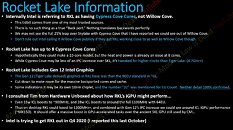Monday, June 15th 2020

Intel "Willow Cove" Backported to 14nm is "Cypress Cove"?
Intel's 11th generation Core "Rocket Lake-S" desktop processor is fascinating as it introduces Intel's first CPU core IPC uptick in about half a decade. Until now, it was rumored that "Rocket Lake-S" features a back-port of Intel's "Willow Cove" CPU cores to the 14 nm silicon fabrication process. It turns out that Intel doesn't want to call these cores "Willow Cove," which make their debut with the 10 nm+ "Tiger Lake" mobile processors later this Summer. Enter "Cypress Cove." A Moore's Law is Dead video presentation sheds light on this mysterious new codename.
Apparently, "Cypress Cove" is the codename Intel is using to refer to the CPU cores Intel is building with its latest CPU core IP on older 14 nm process. Owing to the process, the IPC of these cores may be different from the "Willow Cove" cores on "Tiger Lake," and to avoid confusion, Intel possibly choosing to give it a different internal codename. In other words, Moore's Law is Dead believes that "Cypress Cove" may not offer the alleged 25% IPC gains over "Skylake" that you could expect instead from "Willow Cove" cores in "Tiger Lake."The maximum core count of "Rocket Lake-S" is swinging between 8 and 10, although more sources lean toward 8 than 10. Taking advantage of the increase power budget of the desktop platform, "Cypress Cove" cores could be clocked a lot higher than "Willow Cove" cores on mobile chips such as "Tiger Lake." Next up, while "Rocket Lake-S" is expected to feature Gen12 Xe graphics, it could have a lower execution unit (EU) count than "Tiger Lake," which has 96 of them. Sources of Moore's Law is Dead reinforce the theory from last week of "Rocket Lake-S" being a multi-chip module of CPU cores sitting on a 14 nm die, and the iGPU along with other uncore components on a separate 10 nm die.
Sources tell Moore's Law is Dead that "Rocket Lake-S" is heading toward either a Q4-2020 or Q1-2021 launch, although they lean towards the latter. Find other fascinating insights in the source link below.
Source:
Moore's Law is Dead (YouTube)
Apparently, "Cypress Cove" is the codename Intel is using to refer to the CPU cores Intel is building with its latest CPU core IP on older 14 nm process. Owing to the process, the IPC of these cores may be different from the "Willow Cove" cores on "Tiger Lake," and to avoid confusion, Intel possibly choosing to give it a different internal codename. In other words, Moore's Law is Dead believes that "Cypress Cove" may not offer the alleged 25% IPC gains over "Skylake" that you could expect instead from "Willow Cove" cores in "Tiger Lake."The maximum core count of "Rocket Lake-S" is swinging between 8 and 10, although more sources lean toward 8 than 10. Taking advantage of the increase power budget of the desktop platform, "Cypress Cove" cores could be clocked a lot higher than "Willow Cove" cores on mobile chips such as "Tiger Lake." Next up, while "Rocket Lake-S" is expected to feature Gen12 Xe graphics, it could have a lower execution unit (EU) count than "Tiger Lake," which has 96 of them. Sources of Moore's Law is Dead reinforce the theory from last week of "Rocket Lake-S" being a multi-chip module of CPU cores sitting on a 14 nm die, and the iGPU along with other uncore components on a separate 10 nm die.
Sources tell Moore's Law is Dead that "Rocket Lake-S" is heading toward either a Q4-2020 or Q1-2021 launch, although they lean towards the latter. Find other fascinating insights in the source link below.

35 Comments on Intel "Willow Cove" Backported to 14nm is "Cypress Cove"?
euhm
he should really trade that amd 50th anniversariy shirt for some basic image creation software
Willow Cove: +9%
Cypress Cove: +6%
Dead Cow: +10
skylake is 5 years old and made on 14nm.
we should really have cpus that run circles around it in 2020.
Planned transistor density of 10nm process for wich "Willow Cove" architecture was designed is vastly greater than in ancient 14 nm process:
You can't just "print it bigger"...
Put some makeup and a wig on it and its ready for another five years.
Intel is never moving on to 10 nm for desktop cpu cores. That is at least how it feels. If this continues like this and depending on my economy at the end of this year, if I end up upgrading. I think AMD ZEN 3 sounds like a better option now.
So far so goodHaha I see what you did there
The only lesson we can learn from this is that messing up just one node in the fabrication process can be an extremely hard problem to fix.
I would say that part of the reason why Intel took so long to admit they have a problem and find a solution is the internal bureaucracy and bad culture. A big mammoth company is much slower to adapt to problems and that was very obvious.
Anyway, if Rocket Lake comes out and has better (and I mean, clearly better) gaming performance with reasonable power consumption and similar IPC to Zen 3, I don't think it will be a tragedy for Intel. But if not, they might be in big trouble on the desktop segment in the next year or so.
I wonder what Intel would have done if they didn't have this good Skylake core to keep them in the race during all these years...